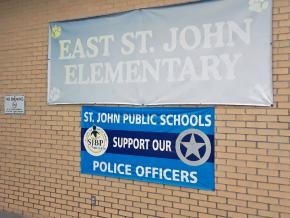Black lives need to matter in schools
A socialist and student teacher in New Orleans questions why students are being told to support the police who often target them for harassment and brutality.
RECENTLY, I passed through the towns of LaPlace and Reserve, Louisiana. These are two working class suburbs of New Orleans, west and upriver along the Mississippi. I went by both the elementary and high school buildings on the east side of the St. John the Baptist (SJTB) Parish (the equivalent to “county”) public school system.
I found that both schools have identical large printed banners hanging on the exterior front walls, emblazoned with the declaration “St. John Public Schools Support Our Police Officers.” The matching banners feature the logos of the Parish public school system and a police badge star side by side.
I must say that I was disgusted, but not particularly surprised. There is an out-and-proud propaganda war all over South Louisiana in the form of individuals, businesses and institutions flying stickers and signs defending and praising the police.
This is supposed to go without any dissent or question. But obviously, it is a forceful political backlash and insult toward the Black Lives Matter movement.

The issue is both local and national. These types of “thin blue line” and police “support” flags stem from the Louisiana watershed moment in 2016 when two cops in Baton Rouge confronted a Black man named Alton Sterling, who was selling CDs in the parking lot of a gas station.
In an attack that was recorded on video — though only released fully after the police killer was let off by prosecutors — police pointed a gun at Sterling at point-blank range, twisted his arm, screamed that he would be shot if he moved, Tasered him twice and then, while he was stunned on the ground, shot him to death.
Reportedly, Sterling had a gun in his pants pocket, but he never drew it before his death. The cop who pulled the trigger was let off by prosecutors, but also fired by the police department for the killing.
Black Baton Rouge residents reacted with immediate mass protests, and police were permitted to mass arrest 200 people for using their right to free speech to criticize the system.
Louisiana has suffered a permanent mass incarceration system and multiple murders of fleeing Black men — for example, by the Jefferson Parish sheriff’s police department — also without facing trial.
So the question is: Why does the public school administration of SJTB Parish think that it can wage a pro-police campaign as if this is a public service announcement? How can it defend, apologize for, and demand polite, “patriotic,” “civic” silence about institutionalized racism?
THE POPULATION of SJTB Parish is 54 percent Black, and like many other areas in Louisiana, there is a visible profusion of private Catholic and Protestant private K-12 schools charging tuition that serve a disproportionately white and economically better off section of kids.
This creates de facto racial segregation, which some white parents will quite openly say is what they want.
I can only say that if I were a student, a parent or a worker in these schools, I would be horrified and outraged. A Black student walking in past a big banner like this — which simultaneously denies and defends the fact that police could murder a member of their community or family at any time and not be punished — is a revolting idea and an insult to the whole idea of teaching.
We need movements of protest to break the surly, racist, enforced cheering for police despite all evidence and enforced silence for so many people facing their attacks.
Both teachers and students — Black, Brown and white — will have to come out and push back against racism to change the kind of arrogantly dishonest setup in which a school administration could even think about getting away with this.
I agree with Tithi Bhattacharya’s point in a recent article on the U.S. teacher strike wave, reporting from Louisville, Kentucky: “The teachers’ revolt must confront racism head on.”
We need to extend the efforts of teacher activists in the last year to bring Black Lives Matter into schools, through teach-ins, discussions, shirts, signs, statements and organizing. Future resistance will have to use the tactics we have seen in the last year, including walkouts and strikes.
We need resistance from within, resistance from below and solidarity.
Black Lives Matter in school!


